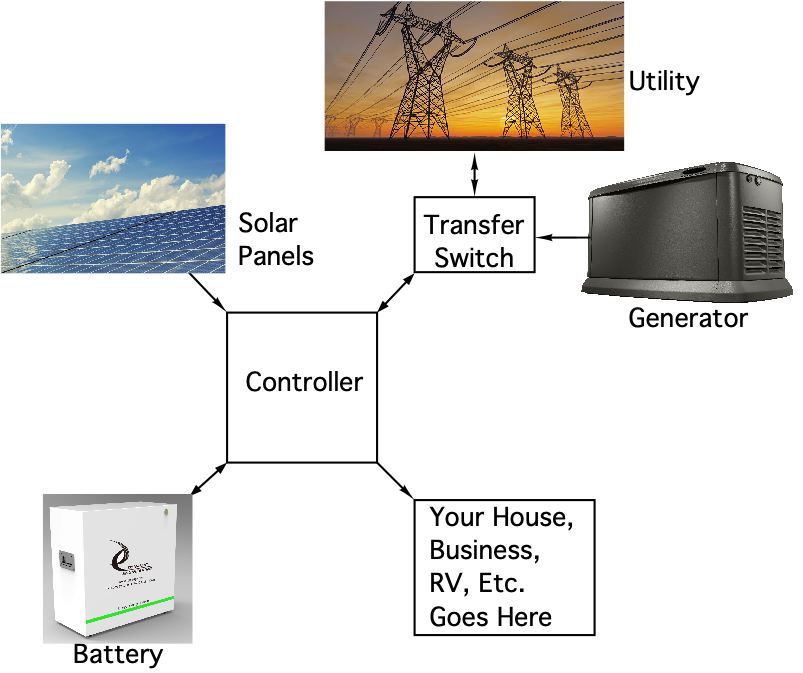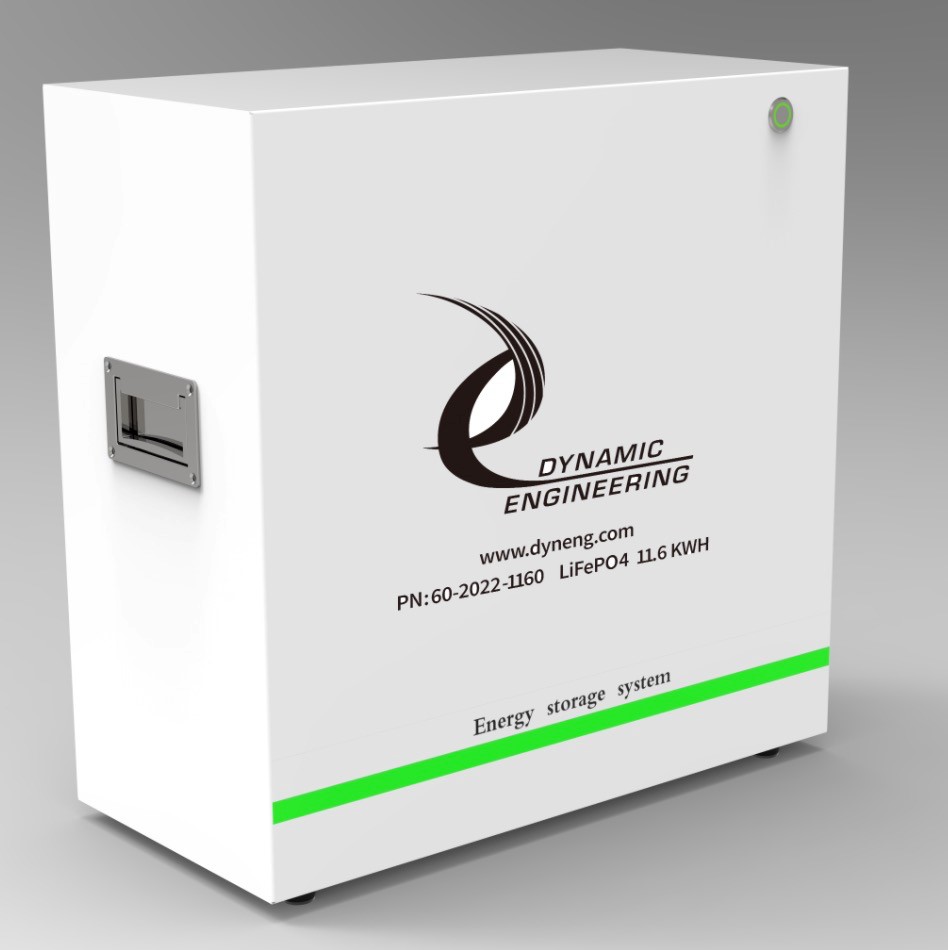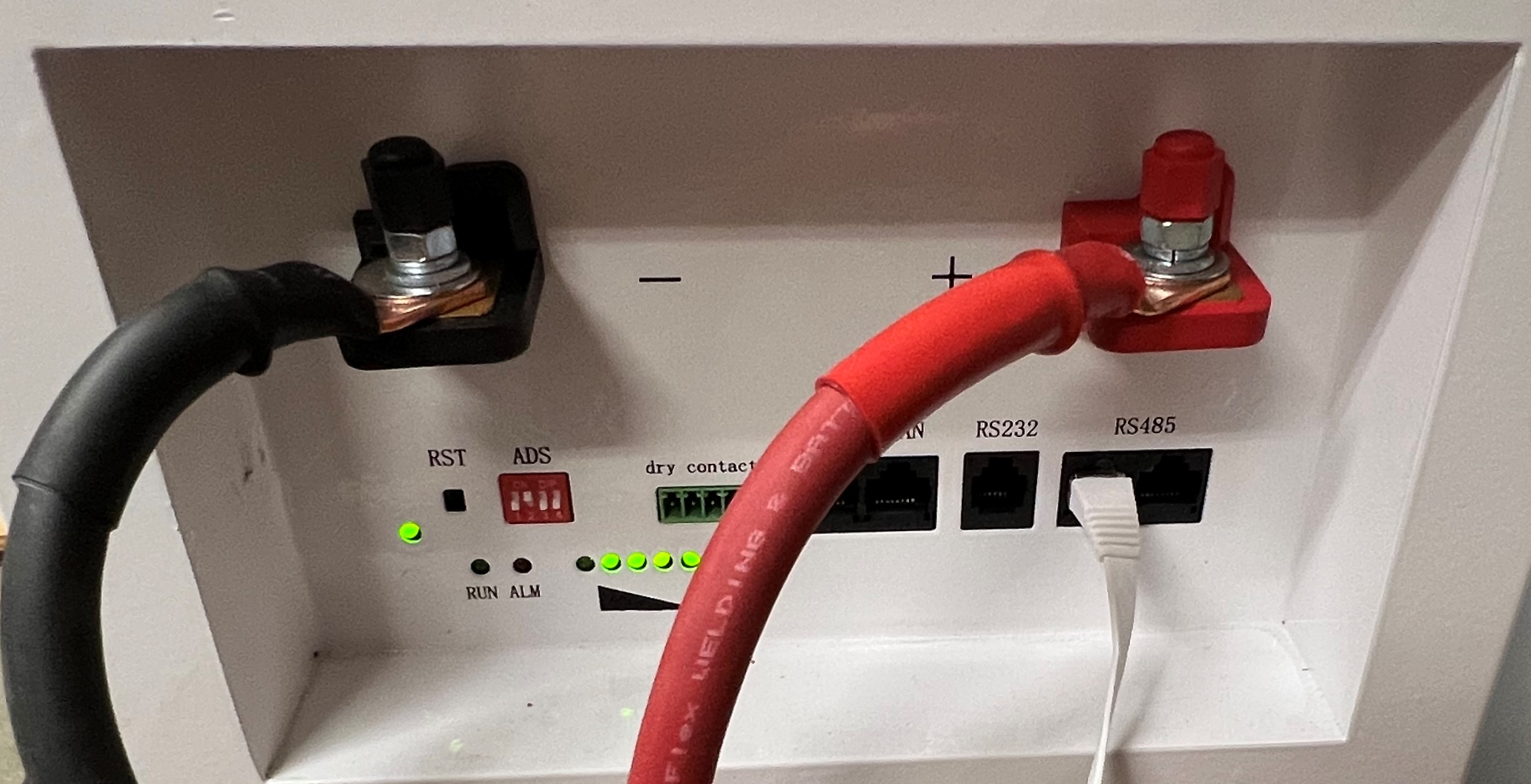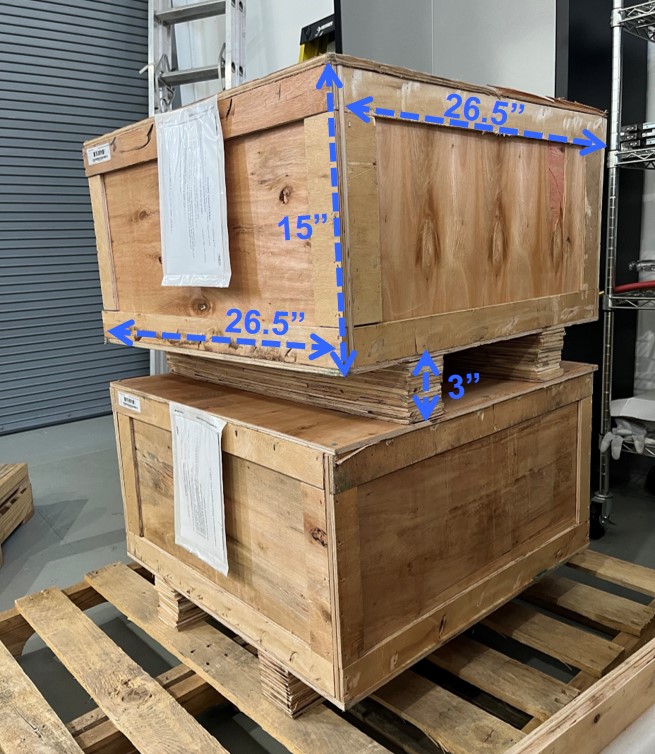LiFePO4 Battery 48V 11.6 KWH 100A BMS
Order This Item
Direct Price : Only $4590.00 ea for 11.6 KWH, 48V, 100A - LiFePO4 industrial quality battery for home and business.See ordering tab for ordering options explanation.
Installers and distributers inquire to sales@dyneng.com
Key Features
- 11.6 KWH
- Up to 100A discharge
- Replaces 48V Lead acid Batteries
- Built in BMS with over current and temperature protection, status port
- Simple parameter entry for your controller
- Safe LiFePO4 cell construction aka Lithium-Iron-Phosphate , LFP or L-F-P
- RS485, RS232, CAN options for communication
- Up to 16 units can be operated in parallel
- LED display for charge level
- Battery life - more than 6000 cycles [80% capacity remaining] 10 year warranty
- Suitable for many applications: Residential and Commercial, Solar / PV system, emergency, off-grid, mobile, Data Server Farm, EV charging station etc.
- Best price per KWH installed in many configurations

LiFePO4 aka LFP (Lithium-Iron-Phosphate, LFP, L-F-P) Batteries are an important element for a complete residential or commercial installation. Battery power is available instantly. A system with battery support acts like a full installation UPS. With a well designed controller and LifePO4 battery bank; your house or business will be protected from brown outs and black outs.
By having batteries in your system, you can use the controller to run from battery during Time Of Use periods [TOU] when the utility cost is much higher. LiFePO4 batteries can pay for themselves by allowing the use of lower cost stored power during the more expensive time. Batteries can suppliment the power generated by mobile systems with PV array or just power the system and recharge at the "office" Batteries can be combined in a parallel combination to increase stored energy (KWH) and maximum instantaneous current. See the manual for a table showing the stored power and current. Up to 16 units means up to 1600 A, and 185.6 KWH. More than enough for most situations.
When the utility goes off-line the battery can be on-line quickly enough not to notice the transition [with a good controller]. In a system with a generator the battery can run the system until at a lower programmed limit. When the lower voltage threshold is achieved the generator is started to run the system and recharge the battery. The generator can recharge the batteries faster than the batteries would be discharged by the system. This behavior means the on-time for the batteries is much longer than the on-time for the generator. Natural gas or Propane is expensive, and the generator is more efficient when run at the higher rate for a shorter time. Batteries make this possible. During daylight the PV may be able to run the load and recharge the batteries depending on the size of the array. Your neighbors will appreciate the time when the generator is not running and you will too as a properly sized battery can mean a silent night.
Large batteries of this nature are systems within themselves. LiFePO4 11.6 KWH is no exception. Within the battery chassis is a small computer known as a "BMS" or Battery Management System. The BMS acts as a local controller for the battery and insures safe operation by monitoring the outgoing current, operating temperatures etc. For detailed information the serial port can be used with your computer. You can see the status of the battery for charging, discharging, current level, voltages etc. The batteries have individual addresses to allow interaction with any of the batteries in a parallel installation without moving cables. If the controller is compatible with the BMS instruction set the controller can interact with the batteries to aide in installation and getting real-time status from the batteries. You can use the batteries without this connection by programming the controller with the voltage levels for charging, operating, max current charge and max current discharge. With most controllers this is easy to do.
Battery Specifications. The stored power, ability to offload current, length of service, size, weight and operating limitations are all key specifications.
Battery Math
Stored Battery Power * efficiency = potential delivered power.
V*I*e = Watts Delivered = RMS voltage * current. Due to the battery being at a lower voltage than the RMS voltage the current delivered to the AC side is lower. For example : Battery at 52V, DC current 20A, e = .955 [from Sol-Ark 12KW] => 993.2W => 8.276A at 120V after conversion. The controller will likely display in terms of KW. Read the owners manual for the efficiency constant and how to interprete the display (before or after conversion).
Thermal Losses
In the example above the loss - power taken from the battery but not delivered to the load [generally becomes heat within the controller] = V*I*(1-e) => 52 * 20 * (1-.955) => 46.8W.
How much power does your house use? The answer is it depends. If you have converted to solar and gone electric with Refrigerators, Hot Water, Heat Pump, Oven, Dryer, well, etc. the load can be significant. There are two kinds of loads as well. When an appliance is first turned on there is an "in rush" current and after steady state a lower maintenance level. The amount of time and amount of current can vary a lot. An oven may use extra current coming up to temperature and then be much less once maintaining the temperature. A larger moter [well pump, heat pump etc.] may have a shorter duration higher intensity spike in requirements. When running on battery [ TOU, off grid, or black out] the current will have to come from the battery.
You can make a spread sheet and get the manufacturers ratings for everything and perform a worst case analysis to determine how much power you need to generate peak and for maintenance. Potentially you can program the devices to reduce the worst case requirement. For example depending on your well volume you might be able to run the well at a time unlikely to have the oven or dryer running. You may need to put in parallel controllers and batteries to support your load.
Parallel Batteries - Battery Banking
Each LiFePO4 11.6KWH battery [our model] can support 11.6 KWH of storage and 100A. Using the calculation above each battery can deliver 4966W to the load from each battery. If you are drawing this load you will have about 2 hours of run time. In our area TOU is 4pm to 9pm = 5 hours. Taking the effiency into the stored power value [11.6 * .955] and using 11.078 KWH we can divide by various wattage loads and see the expected run time. 11.078 / 5 => 2.21 KW or lower would be handled by a single battery. Remember the start-up case as your system may only average 2.2 KW but could easily exceed the 4.96 KW max current.
Many installations have 120/240 power circuits. The power delivered in the calculations above is based on 120V. If running at 240V the wattage is doubled meaning the run time is halved. We have 2 controllers in our set-up to have 240V power support with full rated current to each leg. We have batteries in parallel to support both loads. The batteries are connected in parallel to each other and to both controllers to allow load sharing between the batteries. In our system the max current from the batteries is programmable at the controller. Be careful to set this properly to be the amount of current each unit can draw. There is some measurement error within all controllers. It is recommended to leave some margin at the controller. Instead of programming to 100A use 85-90. The BMS will shut the battery down if too much is being requested by the controller. This will likely shut your sytem down. Most electronics and electrical equipment will last longer and be more reliable if you do not use the max values that can be programmed.
Off-grid systems will need to operate all night rather than just through the TOU or occasional black-out. Batteries can be paralleled up to 16 units. Each battery has a selector to allow a unique address on the chain allowing communication with each battery from a single connection. With 16 batteries in parallel : 100A *16 = 1600 A * 52V => 83 KW before efficiencies and 185.6 KWH. An impressive amount of stored power and maximum current.
Example: assume 8 hours of solar production => 16 hours from battery. Assume 5 KW for the entire time. 5 KW delivered with 11.078 KWH [11.6 * .955] per battery after efficiency reduction [for the controller - modify for your system]. (16 hours * 5 KW )/ 11.078 => 7.22 Batteries would be required. Round up to 8 batteries. In reality most homes do not consume that much power sustained. A few hours at the higher load when running the appliances but not the whole time. Our recommendation is to size the battery wiring for the worst case and purchase 4 batteries to start with [for this scenario]. See what your run time really is and go from there. More batteries can be added to the initial group. Once you have the instantaneous current covered the run time iis expanded by added parallel batteries.
KW = Kilo Watt - this is a flow rate. Your Solar panels generate XX KW. If the power generated is accumulated [integrated] the KWH for the unit of time can be determined. For excample, in the winter the same array may not output the same percentage of capacity at any moment and for a shorter length of time per day leading to a x0, x1 or x2 for the whole day [against the rating of the array]. In summer the amount of available sunlight is greater and the intensity is also greater leading to a larger multiplier - x6+ on my personal system. The integrated generated power is the KWH for the day. Anywhere from close to Zero up to 80 KWH in a day all with the same 12KW rated system.
KWH = Kilo Watt Hour(s) - this is a unit of measure for the amount of power stored - the batteries capacity. 1 Kilo Watt for 1 hour.
Controller Efficiency or conversion factor. The controller in your system uses Solar or Battery power and coverts to Load power. The load can be the utility if selling back or your house / business /vehicle etc. Power from the Solar Array PV (photovoltaic) panels is DC. Power from the batteries is also DC. Power delivered to the load is generally AC. In addition, power from the utility is used to charge the batteries - AC to DC in this case. The conversion from DC to AC or AC to DC is not perfect meaning there are losses associated with the conversion. Lower losses are better for your system life, for your power bill, and for the amount of useful power delivered from the battery.
Transfer Time is the time the controller takes to determine, and take action to switch sources when an event occurs - brown out, black out etc. Better controllers are faster. 4 mS and faster is a good target. Most appliances expect solid power. If the transfer time is very long the power in your installation will reduce in voltage [brown out] and you will see your lights flash and sometimes clocks and other items need to be reset. When the voltage is lower than expected the current used is increased. The increase in current can cause earlier failure of devices on the system, especially if the system is frequently correcting for Utility brown outs. With a faster unit the power switches quickly enough to act as a whole house UPS.
UPS Uninterruptable Power Supply. A device which monitors and frequently filters the local power. When the power input is disrupted, the device uses local storage to supply power to the device. Great protection when using a generator and transfer switch to fill the gap while the generator is coming on-line.
DC Direct Current. The voltage is at a level relative to ground. The voltage is relatively constant - for a battery the fully charged and fully utilized states will be different voltages. The rate of change is slow enough to be considered DC. The voltage decrease is relatively monotonic - not sinusoidal in nature. Power = Current * Voltage for DC applications.
AC Alternating Current. The voltage is sinusoidal. The peak voltage and the commonly measured voltage are not the same values. The handheld meter will display the RMS [root mean square] value for the waveform. Using RMS voltage allows a constant to be applied to sinusoidal waveform. If you integrate the power under the Sine wave to take into account the zero crossing and peak power you end up with the RMS equivalent.
Parallel when applied to controllers and batteries means connecting more than one together to create an increased supply. For example, use two controllers in parallel to double the power delivery, use two batteries in parallel to double the stored power. Sometimes referred to as a battery bank when operating in parallel. Parallel means + to + and - to - which keeps the voltage constant and increases the available storage and current. It is generally inadvisable to connect in series with Lithium batteries.
DOD Depth of Discharge - what percentage of the rated capacity can be utilized [discharged] per cycle and not affect the battery operation [number of cycles] Exceeding the DOD can damage the battery and reduce life-span
Duration The number of hours the battery can support the load. This figure is highly dependent on the load. See Battery Math section for some example calculations.
Battery Efficiency How much of the stored charge is used by the battery compared to how much can be delivered. This number depends on the test set-up as the BMS and other battery associated electronics will draw a fairly constant load while the time to discharge can vary greatly with the load applied. Shorter duration larger loads will appear to have a higher efficiency than smaller loads for a longer period. A better measure is the fraction of a KWH consumed by the battery. Usually this number is small compared to the efficiency loss in the DC/AC conversion - in terms of absolute power consumed.
LiFePO4 is the elemental compound used for Lithium-Iron-Phosphate or LFP. L-F-P is an improvement over straight Lithium batteries as it is much more stable. It is the go-to choice for any application where safety is important. Straight Lithium has better energy density at the cost of safety. Tesla and others have changed from Lithium to LiFePO4 for this reason.
V*I*e = Watts Delivered = RMS voltage * current. Due to the battery being at a lower voltage than the RMS voltage the current delivered to the AC side is lower. For example : Battery at 52V, DC current 20A, e = .955 [from Sol-Ark 12KW] => 993.2W => 8.276A at 120V after conversion. The controller will likely display in terms of KW. Read the owners manual for the efficiency constant and how to interprete the display (before or after conversion).
Thermal Losses
In the example above the loss - power taken from the battery but not delivered to the load [generally becomes heat within the controller] = V*I*(1-e) => 52 * 20 * (1-.955) => 46.8W.
How much power does your house use? The answer is it depends. If you have converted to solar and gone electric with Refrigerators, Hot Water, Heat Pump, Oven, Dryer, well, etc. the load can be significant. There are two kinds of loads as well. When an appliance is first turned on there is an "in rush" current and after steady state a lower maintenance level. The amount of time and amount of current can vary a lot. An oven may use extra current coming up to temperature and then be much less once maintaining the temperature. A larger moter [well pump, heat pump etc.] may have a shorter duration higher intensity spike in requirements. When running on battery [ TOU, off grid, or black out] the current will have to come from the battery.
You can make a spread sheet and get the manufacturers ratings for everything and perform a worst case analysis to determine how much power you need to generate peak and for maintenance. Potentially you can program the devices to reduce the worst case requirement. For example depending on your well volume you might be able to run the well at a time unlikely to have the oven or dryer running. You may need to put in parallel controllers and batteries to support your load.
Parallel Batteries - Battery Banking
Each LiFePO4 11.6KWH battery [our model] can support 11.6 KWH of storage and 100A. Using the calculation above each battery can deliver 4966W to the load from each battery. If you are drawing this load you will have about 2 hours of run time. In our area TOU is 4pm to 9pm = 5 hours. Taking the effiency into the stored power value [11.6 * .955] and using 11.078 KWH we can divide by various wattage loads and see the expected run time. 11.078 / 5 => 2.21 KW or lower would be handled by a single battery. Remember the start-up case as your system may only average 2.2 KW but could easily exceed the 4.96 KW max current.
Many installations have 120/240 power circuits. The power delivered in the calculations above is based on 120V. If running at 240V the wattage is doubled meaning the run time is halved. We have 2 controllers in our set-up to have 240V power support with full rated current to each leg. We have batteries in parallel to support both loads. The batteries are connected in parallel to each other and to both controllers to allow load sharing between the batteries. In our system the max current from the batteries is programmable at the controller. Be careful to set this properly to be the amount of current each unit can draw. There is some measurement error within all controllers. It is recommended to leave some margin at the controller. Instead of programming to 100A use 85-90. The BMS will shut the battery down if too much is being requested by the controller. This will likely shut your sytem down. Most electronics and electrical equipment will last longer and be more reliable if you do not use the max values that can be programmed.
Off-grid systems will need to operate all night rather than just through the TOU or occasional black-out. Batteries can be paralleled up to 16 units. Each battery has a selector to allow a unique address on the chain allowing communication with each battery from a single connection. With 16 batteries in parallel : 100A *16 = 1600 A * 52V => 83 KW before efficiencies and 185.6 KWH. An impressive amount of stored power and maximum current.
Example: assume 8 hours of solar production => 16 hours from battery. Assume 5 KW for the entire time. 5 KW delivered with 11.078 KWH [11.6 * .955] per battery after efficiency reduction [for the controller - modify for your system]. (16 hours * 5 KW )/ 11.078 => 7.22 Batteries would be required. Round up to 8 batteries. In reality most homes do not consume that much power sustained. A few hours at the higher load when running the appliances but not the whole time. Our recommendation is to size the battery wiring for the worst case and purchase 4 batteries to start with [for this scenario]. See what your run time really is and go from there. More batteries can be added to the initial group. Once you have the instantaneous current covered the run time iis expanded by added parallel batteries.
Definitions and Clarifications:
Part Number: LiFePO4 XXX KWH
Ordering Options
- LiFePO4 - 60-2022-1160 = PN. LiFePO4 Lithium-Iron-Phosphate rechargable battery. 100A, 11.6 KWH, 6000+ discharge / recharge cycles. One Serial cable set per order. Lead time is stock to 80 days. Batteries are billed 50% down, 50% when ready to ship. Batteries can be shipped or picked up from our facility.
Dynamic Engineering has high standards. Occasionally units are produced with very slight "hard to see" cosmetic blemishes. A Discount is available when units are available. By selecting the "Cosmetic Discount" in the store front you are agreeing to purchase a unit with some non-standard surface anomolies if we have the units in stock and to accept non-damaged units without the discount if not available. We can confirm by e-mail or phone ahead of ordering if desired.
Manuals
Manual for LiFePO4 11.6KWH in PDF format.



